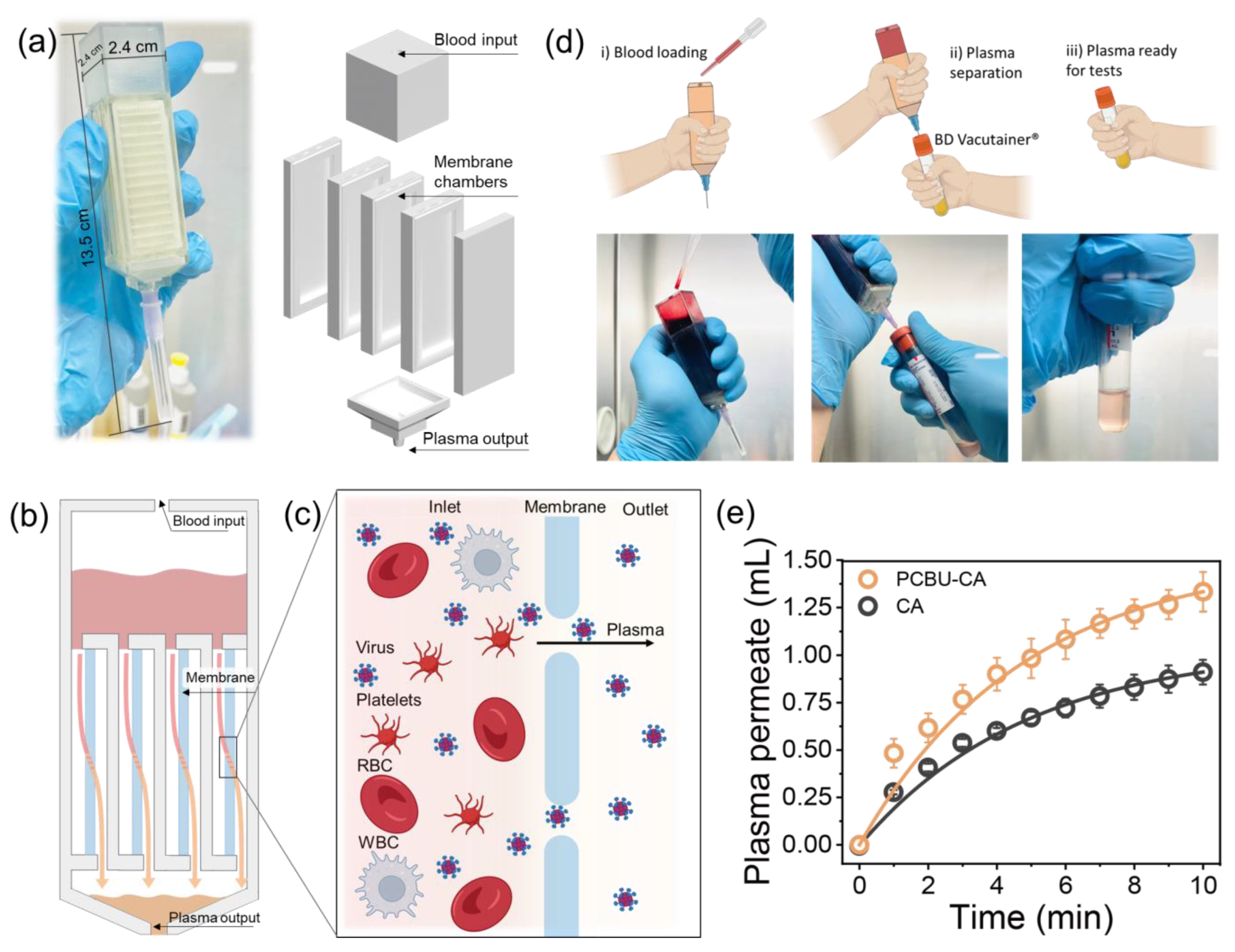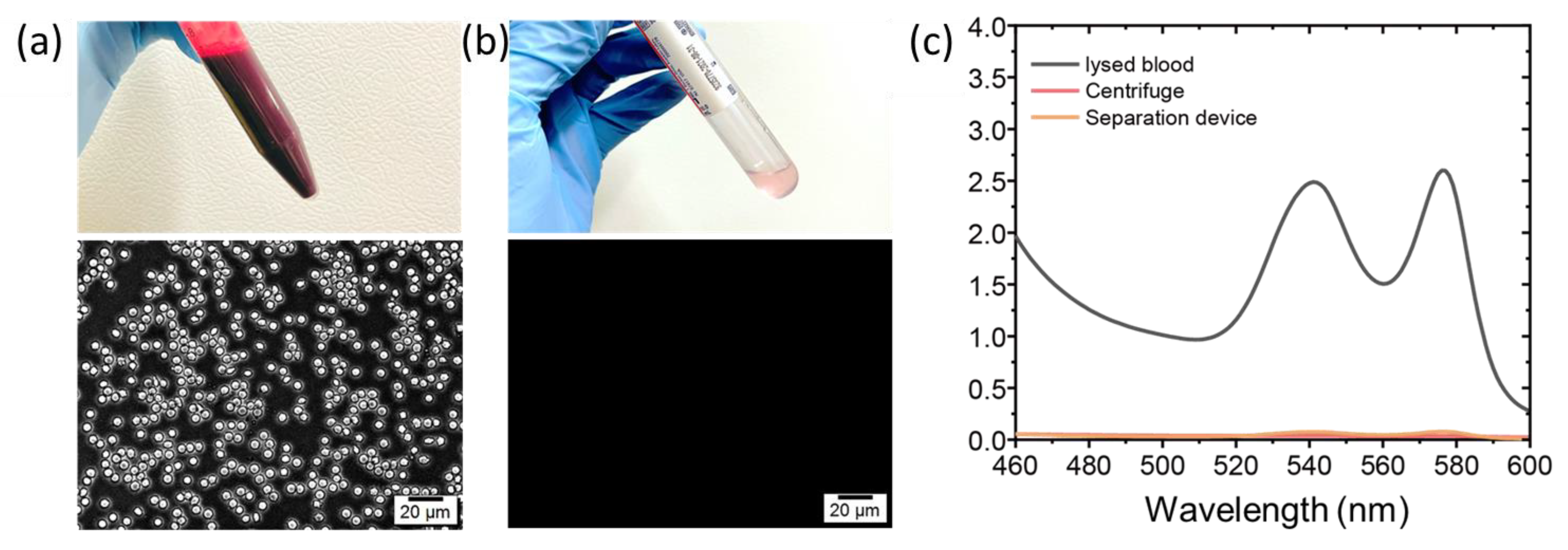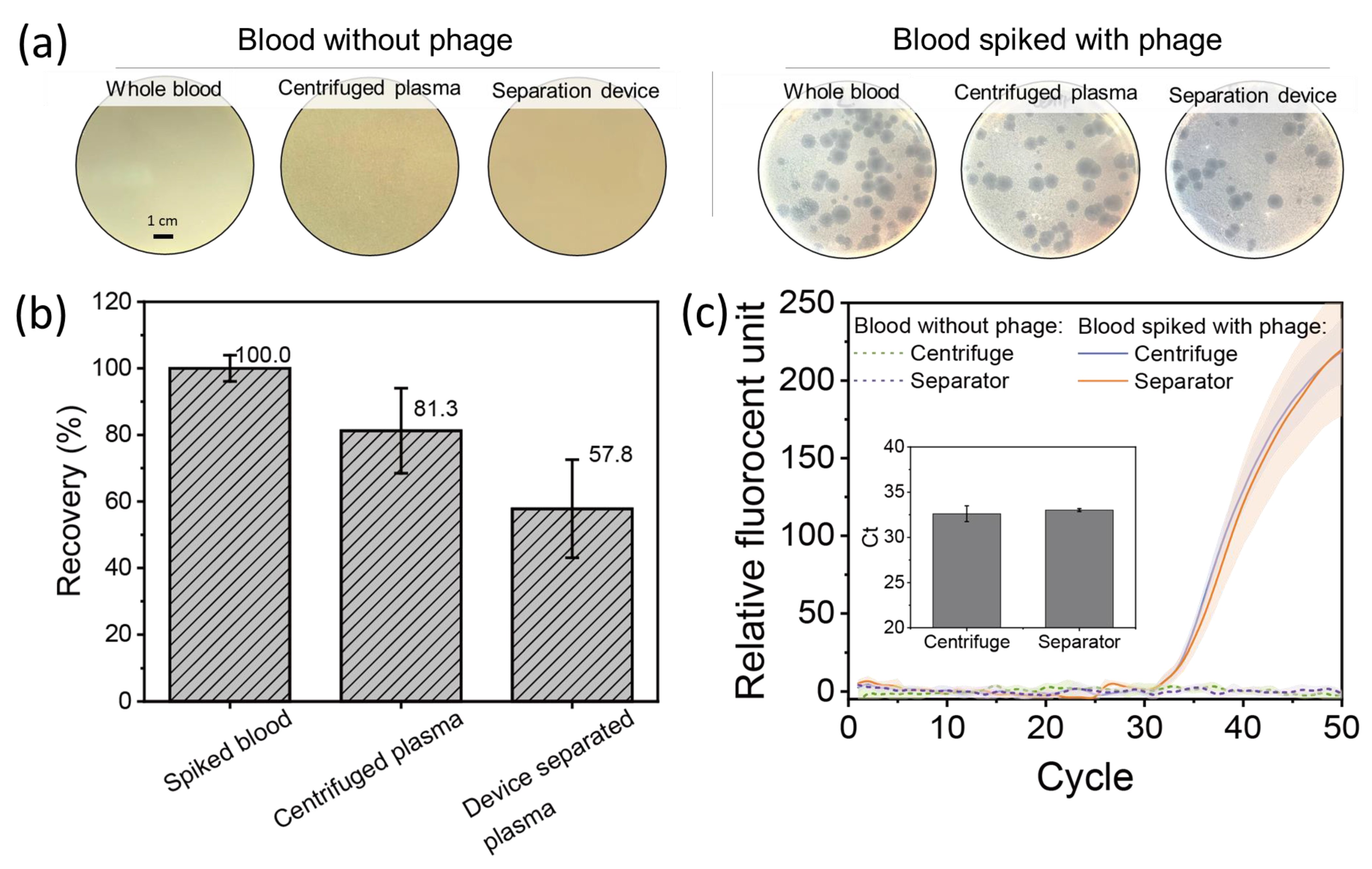Simple Bioparticle Filtration Device Based on an Ultralow-Fouling Zwitterionic Polyurethane Membrane for Rapid Large-Volume Separation of Plasma and Viruses from Whole Blood
Abstract
:1. Introduction
2. Experimental Section
2.1. Materials
2.2. Membrane Preparation and Characterization
2.3. Virus/Plasma Separation Design and Assembly
2.4. Phage Separation Test
2.5. Phage Recovery Quantification
3. Results and Discussion
3.1. Membrane Preparation and Characterization
3.2. Plasma Separation Performance of the PCBU-CA Membrane Device
3.3. Phage Recovery
4. Conclusions
Supplementary Materials
Author Contributions
Funding
Institutional Review Board Statement
Data Availability Statement
Acknowledgments
Conflicts of Interest
References
- Drain, P.K.; Dorward, J.; Bender, A.; Lillis, L.; Marinucci, F.; Sacks, J.; Bershteyn, A.; Boyle, D.S.; Posner, J.D.; Garrett, N. Point-Of-Care HIV Viral Load Testing: An Essential Tool for a Sustainable Global HIV/AIDS Response. Clin. Microbiol. Rev. 2019, 32, e00097-18. [Google Scholar] [CrossRef]
- Brainard, J.; Pond, K.; Hooper, L.; Edmunds, K.; Hunter, P. Presence and persistence of Ebola or Marburg virus in patients and survivors: A rapid systematic review. PLoS Negl. Trop. Dis. 2016, 10, e0004475. [Google Scholar] [CrossRef] [PubMed]
- Trivedi, M.; Patil, S.; Shettigar, H.; Mondal, S.C.; Jana, S. Evaluation of biofield modality on viral load of Hepatitis B and C viruses. J. Antivir. Antiretrovir. 2015, 3, 83–88. [Google Scholar]
- Hasanoglu, I.; Korukluoglu, G.; Asilturk, D.; Cosgun, Y.; Kalem, A.K.; Altas, A.B.; Kayaaslan, B.; Eser, F.; Kuzucu, E.A.; Guner, R. Higher viral loads in asymptomatic COVID-19 patients might be the invisible part of the iceberg. Infection 2021, 49, 117–126. [Google Scholar] [CrossRef]
- Mazzola, L.; Pérez-Casas, C. HIV/AIDS Diagnostics Technology Landscape, 5th ed.; UNITAID: Geneva, Switzerland, 2015; pp. 66–68. [Google Scholar]
- Al-Soud, W.A.; Radstrom, P. Purification and characterization of PCR-inhibitory components in blood cells. J. Clin. Microbiol. 2001, 39, 485–493. [Google Scholar] [CrossRef]
- Mabey, D.; Peeling, R.W.; Ustianowski, A.; Perkins, M.D. Diagnostics for the developing world. Nat. Rev. Microbiol. 2004, 2, 231–240. [Google Scholar] [CrossRef] [PubMed]
- Igila, A.F. Quality assurance in medical laboratories in developing countries: Assessment of pre-analytical errors in a chemical pathology laboratory in a tertiary hospital in nigeria. J. Health Med. Sci. 2020, 3, 1–11. [Google Scholar] [CrossRef]
- Buthelezi, E.P. Large academic hospital laboratory investigates a major pre-analytical challenge in africa and developing countries. Lab. Med. 2019, 3, 10–18. [Google Scholar] [CrossRef]
- Zhao, C.; Cheng, X. Microfluidic separation of viruses from blood cells based on intrinsic transport processes. Biomicrofluidics 2011, 5, 032004. [Google Scholar] [CrossRef]
- Wang, S.; Sarenac, D.; Chen, M.H.; Huang, S.-H.; Giguel, F.F.; Kuritzkes, D.R.; Demirci, U. Simple filter microchip for rapid separation of plasma and viruses from whole blood. Int. J. Nanomed. 2012, 7, 5019. [Google Scholar]
- Galligan, C.; Nichols, J.; Kvam, E.; Spooner, P.; Gettings, R.; Zhu, L.; Puleo, C.M. Mesoscale blood cell sedimentation for processing millilitre sample volumes. Lab Chip 2015, 15, 3274–3277. [Google Scholar] [CrossRef] [PubMed]
- Yeh, Y.-T.; Nisic, M.; Yu, X.; Xia, Y.; Zheng, S.-Y. Point-of-care microdevices for blood plasma analysis in viral infectious diseases. Ann. Biomed. Eng. 2014, 42, 2333–2343. [Google Scholar] [CrossRef] [PubMed]
- Wong, A.P.; Gupta, M.; Shevkoplyas, S.S.; Whitesides, G.M. Egg beater as centrifuge: Isolating human blood plasma from whole blood in resource-poor settings. Lab Chip 2008, 8, 2032–2037. [Google Scholar] [CrossRef] [PubMed]
- Liu, C.-H.; Chen, C.-A.; Chen, S.-J.; Tsai, T.-T.; Chu, C.-C.; Chang, C.-C.; Chen, C.-F. Blood plasma separation using a fidget-spinner. Anal. Chem. 2018, 91, 1247–1253. [Google Scholar] [CrossRef] [PubMed]
- Cho, Y.-K.; Lee, J.-G.; Park, J.-M.; Lee, B.-S.; Lee, Y.; Ko, C. One-step pathogen specific DNA extraction from whole blood on a centrifugal microfluidic device. Lab Chip 2007, 7, 565–573. [Google Scholar] [CrossRef] [PubMed]
- Vemulapati, S.; Erickson, D. Portable resource-independent blood–plasma separator. Anal. Chem. 2019, 91, 14824–14828. [Google Scholar] [CrossRef]
- Vemulapati, S.; Erickson, D. H.E.R.M.E.S: Rapid blood-plasma separation at the point-of-need. Lab Chip 2018, 18, 3285–3292. [Google Scholar] [CrossRef]
- Liu, C.; Mauk, M.; Gross, R.; Bushman, F.D.; Edelstein, P.H.; Collman, R.G.; Bau, H.H. Membrane-based, sedimentation-assisted plasma separator for point-of-care applications. Anal. Chem. 2013, 85, 10463–10470. [Google Scholar] [CrossRef]
- Wang, K.; Seol, H.; Liu, X.; Wang, H.; Cheng, G.; Kim, S. Ultralow-Fouling Zwitterionic Polyurethane-Modified Membranes for Rapid Separation of Plasma from Whole Blood. Langmuir 2021, 37, 10115–10125. [Google Scholar] [CrossRef]
- Son, J.H.; Lee, S.H.; Hong, S.; Park, S.M.; Lee, J.; Dickey, A.M.; Lee, L.P. Hemolysis-free blood plasma separation. Lab Chip 2014, 14, 2287–2292. [Google Scholar] [CrossRef] [PubMed]
- Nabatiyan, A.; Parpia, Z.A.; Elghanian, R.; Kelso, D.M. Membrane-based plasma collection device for point-of-care diagnosis of HIV. J. Virol. Methods 2011, 173, 37–42. [Google Scholar] [CrossRef]
- Mielczarek, W.S.; Obaje, E.A.; Bachmann, T.T.; Kersaudy-Kerhoas, M. Microfluidic blood plasma separation for medical diagnostics: Is it worth it? Lab Chip 2016, 16, 3441–3448. [Google Scholar] [CrossRef]
- Cepheid. Xpert® HIV-1 Viral Load. Available online: https://cepheid.widen.net/content/xwv1mxvmlp/pdf/Cepheid-Xpert-HIV-1-Viral-Load-Brochure-CE-IVD-3039-English.pdf?u=bk12mm (accessed on 14 May 2023).
- Kersaudy-Kerhoas, M.; Sollier, E. Micro-scale blood plasma separation: From acoustophoresis to egg-beaters. Lab Chip 2013, 13, 3323. [Google Scholar] [CrossRef] [PubMed]
- Wang, H.; Christiansen, D.E.; Mehraeen, S.; Cheng, G. Winning the fight against biofilms: The first six-month study showing no biofilm formation on zwitterionic polyurethanes. Chem. Sci. 2020, 11, 4709–4721. [Google Scholar] [CrossRef] [PubMed]
- Peng, X.; Leal, J.; Mohanty, R.; Soto, M.; Ghosh, D. Quantitative PCR of T7 bacteriophage from biopanning. J. Vis. Exp. 2018, 139, e58165. [Google Scholar]
- Zhou, X.; Sun, Y.; Shen, S.; Li, Y.; Bai, R. Highly effective anti-organic fouling performance of a modified PVDF membrane using a triple-component copolymer of P (Stx-co-MAAy)-g-fPEGz as the additive. Membranes 2021, 11, 951. [Google Scholar] [CrossRef] [PubMed]
- Decher, G. Fuzzy nanoassemblies: Toward layered polymeric multicomposites. Science 1997, 277, 1232–1237. [Google Scholar] [CrossRef]
- Ouyang, L.; Malaisamy, R.; Bruening, M.L. Multilayer polyelectrolyte films as nanofiltration membranes for separating monovalent and divalent cations. J. Membr. Sci. 2008, 310, 76–84. [Google Scholar] [CrossRef]
- Krishna, D.N.G.; Philip, J. Review on surface-characterization applications of X-ray photoelectron spectroscopy (XPS): Recent developments and challenges. Appl. Surf. Sci. Adv. 2022, 12, 100332. [Google Scholar] [CrossRef]
- Huang, Z.; Nazifi, S.; Cheng, K.; Karim, A.; Ghasemi, H. Scalable inter-diffused zwitterionic polyurethanes for durable antibacterial coatings. Chem. Eng. J. 2021, 422, 130085. [Google Scholar] [CrossRef]
- Wang, H.; Liu, X.; Christiansen, D.E.; Fattahpour, S.; Wang, K.; Song, H.; Mehraeen, S.; Cheng, G. Thermoplastic polyurethane with controllable degradation and critical anti-fouling properties. Biomater. Sci. 2021, 9, 1381–1396. [Google Scholar] [CrossRef] [PubMed]
- Maggay, I.V.B.; Aini, H.N.; Lagman, M.M.G.; Tang, S.-H.; Aquino, R.R.; Chang, Y.; Venault, A. A Biofouling Resistant Zwitterionic Polysulfone Membrane Prepared by a Dual-Bath Procedure. Membranes 2022, 12, 69. [Google Scholar] [CrossRef] [PubMed]
- Storms, M.; Kadhem, A.J.; Xiang, S.; Bernards, M.; Gentile, G.J.; Fidalgo de Cortalezzi, M.M. Enhancement of the fouling resistance of zwitterion coated ceramic membranes. Membranes 2020, 10, 210. [Google Scholar] [CrossRef]
- Huang, Z.; Nazifi, S.; Hakimian, A.; Firuznia, R.; Ghasemi, H. “Built to Last”: Plant-Based Eco-Friendly Durable Antibacterial Coatings. ACS Appl. Mater. Interfaces 2022, 14, 43681–43689. [Google Scholar] [CrossRef] [PubMed]
- Janeca, A.; Rodrigues, F.S.C.; Gonçalves, M.C.; Faria, M. Novel Cellulose Acetate-Based Monophasic Hybrid Membranes for Improved Blood Purification Devices: Characterization under Dynamic Conditions. Membranes 2021, 11, 825. [Google Scholar] [CrossRef] [PubMed]
- Su, X.; Zhang, J.; Zhang, D.; Wang, Y.; Chen, M.; Weng, Z.; Wang, J.; Zeng, J.; Zhang, Y.; Zhang, S. High-Efficiency Plasma Separator Based on Immunocapture and Filtration. Micromachines 2020, 11, 352. [Google Scholar] [CrossRef] [PubMed]
- Liu, C.; Liao, S.C.; Song, J.; Mauk, M.G.; Li, X.; Wu, G.; Ge, D.; Greenberg, R.M.; Yang, S.; Bau, H.H. A high-efficiency superhydrophobic plasma separator. Lab Chip 2016, 16, 553–560. [Google Scholar] [CrossRef]
- Qiu, X.; Jiang, H.; Zhang, X.; Li, K.; Ge, S.; Xia, N.; Mauk, M.G. A plasma separator with a multifunctional deformable chamber equipped with a porous membrane for point-of-care diagnostics. Analyst 2020, 145, 6138–6147. [Google Scholar] [CrossRef]
- World Health Organization. Consolidated Guidelines on the Use of Antiretroviral Drugs for Treating and Preventing HIV Infection; World Health Organization: Geneva, Switzerland, 2013. [Google Scholar]
- Bamford, D.; Zuckerman, M. Encyclopedia of Virology; Academic Press: Cambridge, MA, USA, 2021. [Google Scholar]
- Zydney, A.L.; Saltzman, W.M.; Colton, C.K. Hydraulic resistance of red cell beds in an unstirred filtration cell. Chem. Eng. Sci. 1989, 44, 147–159. [Google Scholar] [CrossRef]




Disclaimer/Publisher’s Note: The statements, opinions and data contained in all publications are solely those of the individual author(s) and contributor(s) and not of MDPI and/or the editor(s). MDPI and/or the editor(s) disclaim responsibility for any injury to people or property resulting from any ideas, methods, instructions or products referred to in the content. |
© 2023 by the authors. Licensee MDPI, Basel, Switzerland. This article is an open access article distributed under the terms and conditions of the Creative Commons Attribution (CC BY) license (https://creativecommons.org/licenses/by/4.0/).
Share and Cite
Wang, K.; Seol, H.; Cheng, A.; McKeague, N.; Carlson, M.; Degraff, W.; Huang, S.; Kim, S. Simple Bioparticle Filtration Device Based on an Ultralow-Fouling Zwitterionic Polyurethane Membrane for Rapid Large-Volume Separation of Plasma and Viruses from Whole Blood. Membranes 2023, 13, 524. https://doi.org/10.3390/membranes13050524
Wang K, Seol H, Cheng A, McKeague N, Carlson M, Degraff W, Huang S, Kim S. Simple Bioparticle Filtration Device Based on an Ultralow-Fouling Zwitterionic Polyurethane Membrane for Rapid Large-Volume Separation of Plasma and Viruses from Whole Blood. Membranes. 2023; 13(5):524. https://doi.org/10.3390/membranes13050524
Chicago/Turabian StyleWang, Kun, Hyang Seol, Alex Cheng, Nash McKeague, Megan Carlson, Wade Degraff, Sijia Huang, and Sangil Kim. 2023. "Simple Bioparticle Filtration Device Based on an Ultralow-Fouling Zwitterionic Polyurethane Membrane for Rapid Large-Volume Separation of Plasma and Viruses from Whole Blood" Membranes 13, no. 5: 524. https://doi.org/10.3390/membranes13050524




